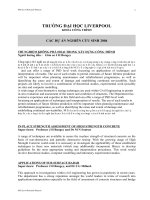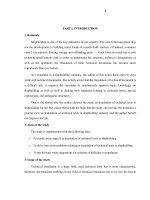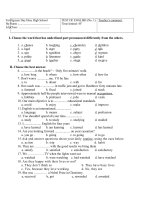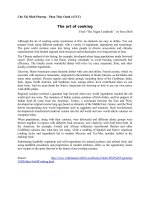Manufacture of metallurgical coke
Bạn đang xem bản rút gọn của tài liệu. Xem và tải ngay bản đầy đủ của tài liệu tại đây (1.17 MB, 52 trang )
Manufacture of Metallurgical Coke
Cost: Coke should be cheap and easily available.
Manufacture of Metallurgical Coke:
(i)
Beehive Oven
(ii) Otto Hoffmann oven
(i) Beehive oven: A beehive oven is a fire-brick chamber having a dome-shaped structure.
The dimensions of a typical oven are 4m and 2.5m high. The roof is provided with a hole
for charging the coal from the top. Another hole, the discharging hole is provided in the
circumference of the lower part of the wall. A number of ovens are built in a row with
common walls between neighbouring ovens.
Fig. 5: Beehive coke oven
Demerits of Beehive ovens: The demerits are
• No recovery of byproducts, which are useful chemicals and are allowed to escape.
• Lower coke yield due to partial combustion
• Lack of flexibility of operation
(ii) Otto-Hoffmann’s oven or By-product Oven: The beehive ovens have been replaced by
chamber ovens which works on regenerative principle of heat economy. All the valuable
products are recovered from the outgoing flue gases.
Construction: It consists of no. of narrow rectangular chambers made of silica bricks.
Fig. 6: A single chamber of Otto Hoffmann’s oven
Working: Coal is charged into the chamber.
o
The coke ovens are heated to 1200 C by burning gaseous fuels.
The process of carbonization takes place layer by layer in the coal charge.
As the coal adjacent to the oven walls gets heated, a plastic zone is formed which moves
away from the walls towards the central zone.
As the coal is converted into coke, there is decrease in volume. This is because of the
o
removal of volatile matter in the form of tar and gas at about 500 C. At further high
temperature, the plastic mass solidifies into hard and porous mass called coke.
Regenerative principle is employed to achieve as economical heating as possible.
Regenerators are built underneath the ovens.The flue gases pass their heat to the checker
o
brick work of regenerators until the temperature rises to 1000 C.
Regenerators work on the principle of alternate heating and cooling cycles. This is achieved by
periodically changing the direction of flow of gases through the vertical flues every 30 min or
so.
Carbonization of a charge of coal takes about 11-18 hours. After the process is complete, red
hot coke is pushed outside by means of a ram which is electrically driven. The coke falls into a
quenching car. The yield is 75 % of coal.
Fig. 7: Otto Hoffmann’s Byproduct coke oven
Recovery of byproducts: The gases and vapours evolved on carbonization in coke ovens
are not allowed to mix with the combustion and are collected separately.The coke oven gas is
treated separately for the recovery of the valuable byproducts.
Fig. 8: Coke-Oven gas treatment plant
(i)
Recovery of Tar: The gas from the coke ovens is passed through a tower in which
liquor ammonia is sprayed.Tar and dust get collected in a tank. The tank is provided
with a heating coils to recover back ammonia.
(ii) Recovery of ammonia: The gases are then passed through a tower where water is
sprayed to recover ammonia. The ammonia can also be recovered by dissolving it in
H2SO4 to form (NH4)2SO4, which is then used as a fertilizer.
(iii) Recovery of Naphthalene: The gases are passed through a cooling tower, where
water at a low temperature is sprayed.The gas is scrubbed with water until its temp.
reduces.
(iv) Recovery of Benzol: The gases are then introduced into a light oil or benzol scrubber,
where benzene along with its homologue is removed and is collected at the bottom.
(v) Recovery of H2S and other S compounds: are removed from the coke oven gas after
the light oil has been separated out.
Fe O + 3H S → Fe S + 3H O
2 3
2
2 3
2
The SO2 obtained can be used for the manufacturing of sulphuric acid, which can be used to
2Fe S +4O → 2FeO + 3SO
absorb NH3 from the coal gas.
2 3
2
2
4FeO + O → 2Fe O
2
2 3
Liquid Fuels: The importance of liquid fuels is the fact that almost all combustion engines run
on them.
The largest source of liquid fuels is petroleum. The calorific value of petroleum is about 40000
kJ/kg.
There are other supplements of liquid fuels such as coal tar, crude benzol, syntheic liquid fuel
made from coal etc.
Petroleum: The term petroleum means rock oil. It is also called mineral oil.
Petroleum is a complex mixture of paraffinic, olefinic and aromatic hydrocarbons with small
quantities of organic compounds containing oxygen, nitrogen and sulphur.
Composition:
Element
Carbon
Hydrogen
Sulphur
Oxygen
Nitrogen
Percentage
80-87
11.1-15
0.1-3.5
0.1-0.9
0.4-0.9
The ash of the crude oil is 0.1%.Metals e.g., Silicon, iron, aluminium, calcium, magnesium,
nickel and sodium.
Crude oil is a mixture of straight chain paraffins and aromatic hydrocarbons e.g., benzene,
toluene, naphthalenes etc.
Sulphur is present in the form of derivatives of hydrocarbons such as alkylsulphides, aromatic
sulphides etc. Nitrogen is present in the form of pyridine, quinoline derivatives, pyrrole etc.
Comined oxygen is present as carboxylic acids, ketones and phenols.
The objectionable odour of crude petroleum is due to the presence of sulphur compounds in
it.
Classification of Crude Petroleum
Residue obtained after distillation
Name
Contents
Paraffin wax
Paraffin base
Straight chain hydrocarbons and small
amounts naphthenes and aromatic
hydrocarbons
Aromatic and naphthenic hydrocarbons
Asphaltic base
Asphalt
Paraffin wax and asphalt
Mixed base
Paraffins, naphthenes and aromatic
hydrocarbons
Processing of Crude Petroleum:
Petroleum is found deep below the earth crust. The oil is found floating over salt water or
brine. Generally, accumulation of natural gas occurs above the oil.
Fig. 9: Pumping of oil
Refining of Petroleum
Crude oil reaching the surface, generally consists of a mixture of solid, liquid and gaseous
hydrocarbons containing sand and water.
After the removal of dirt, water and much of the associated natural gas, the crude oil is
separated into a no of useful fractions by fractional distillation.
The resultant fractions are then subjected to purification known as refining of petroleum.
Steps involved in refining of petroleum:
(i) Demulsification: The crude oil coming out from the well, is in the form of stable emulsion
of oil and salt water, which is yellow to dark brown in colour.
The demulsification is achieved by Cottrell’s process, in which the water is removed from the
oil by electrical process. The crude oil is subjected to an electrical field, when droplets of
colloidal water coalesce to form large drops which separate out from the oil.
(ii) Removal of harmful impurities: Excessive salt content such as NaCl and MgCl2 can
corrode the refining equipment. These are removed by washing with water.
The objectionable sulphur compound are removed by treating the oil with copper oxide. The
copper sulphide so formed is separated by filtration.
(iii) Fractional Distillation: It is done in tall fractionating tower or column made up of steel.
o
In continuous process, the crude oil is preheated to 350-380 C in specially designed tubular
furnace known as pipe still.
Fig. 10: Fractional
distillation of crude
petroleum
The hot vapours from the crude are passed through a tall fractionating column, called bubble
tower.
Bubble tower consists of horizontal trays provided with a no of small chimneys, through which
vapours rise.
These chimneys are covered with loose caps, known as bubble caps. These bubble caps help
to provide an intimate contact between the escaping vapours and down coming liquid.
The temperature in the fractionating tower decreases gradually on moving upwards.
As the vapours of the crude oil go up, they become gradually cooler and fractional
condensation takes place at different heights of column.
The residue from the bottom of the fractionating tower is vacuum distilled to recover various
fractions
Fig. 11: Vacuum distillation of residual oil
There is yet another type of fractional distillation called Top-flashing.
Fig. 11: Top Flashing
In top flashing, there is better control of product composition, but requires more pumps and
instruments and hence is an expensive process.
Cracking: Gasoline is the most imp fraction of crude petroleum. The yield of this fraction is
only 20% of the crude oil. The yield of heavier petroleum fraction is quite high. Therefore,
heavier fractions are converted into more useful fraction, gasoline.
This is achieved by a technique called cracking.
Cracking is the process by which heavier fractions are converted into lighter fractions by the
application of heat, with or without catalyst. Cracking involves the rupture of C-C and C-H
bonds in the chains of high molecular weight hydrocarbons.
e.g:
C H Cracking
→ C H
+C H
5 12 5 10
10 22
Decane
n - pentane pentene
B.Pt =174ο C
B.Pt = 36ο C
C H Cracking
→ C H
+C H
5 12 3 6
8 18
Nearly 50% of today’s gasoline is obtained by cracking. The gasoline obtained by cracking is
far more superior than straight run gasoline.
The process of cracking involves the following chemical changes:
• Higher hydrocarbons are converted to lower
hydrocarbons by C-C cleavage. The product obtained on cracking have low boiling points than
initial reactant.
• Formation of branched chain hydrocarbons takes place from straight chain alkanes.
• Unsaturated hydrocarbons are obtained from saturated hydrocarbons.
• Cyclization may takes place.
Cracking can also be used for the production of olefins from naphthas, oil gas from kerosene.
Cracking can be carried out by two methods









